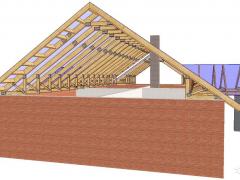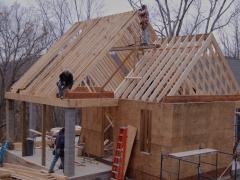A guideline on how to build a gable roof. Proper insulation and waterproofing of a gable roof. Mounting the gable-end overhang.
Technology and the process of installing of a gable roof is considered to be the simplest of all structural solutions. An important point is that this type of a roof is diverse and there is no necessity to conduct building according to a certain standard draft. When planning how to build a gable roof you should know that there are several types of gable roofs: with different slopes, with wide gable-end and overhang construction.
Gabled roof is regarded to be the most practical design. The snow slides off this roof under its own weight, and it is protected from the stagnation of water in summer.
What are major advantages of choosing this type of roof?
- Slight load on the foundation.
- Low cost of the roofing.
- You don’t need help of the experts.
- No negotiation with the architect.
- Additional living space.
- No special equipment.
The gable roof design is planned in order not only to withstand wind gust and weight of the fallen snow, but also to evenly spread and convey the roof pressure on the walls and the house foundation. To calculate a gable roof elements, use an online gable calculator.
Step by step construction of the gable roof:
1. Make the lathing
Type of the lathing depends on the aim of the roof. For metal tiles sparse lathing will be suitable, but for bituminous tiles solid lathing will do.
2. Make a truss system
 Compile the rafters on the ground, and then raise the prepared sections upwards. Each section is fixed to the wall plate. Start with the two outer sections, and align all the middle sections according to them. Other parts, i.e. overhangs, pillars, beams, ridge and so on are installed afterwards as additional elements.
Compile the rafters on the ground, and then raise the prepared sections upwards. Each section is fixed to the wall plate. Start with the two outer sections, and align all the middle sections according to them. Other parts, i.e. overhangs, pillars, beams, ridge and so on are installed afterwards as additional elements.
Usually, the rafters are made of trimmed boards of at least 2×6 inches. The wall plate is made of wooden beam of 6×6 inches. For longitudinal beams and adjacent props all boards of 2×6 inches size are allocated, but double only.
3. Fasten the wall plate
Fasten the wall plate securely as all the roof structure will lean on it. Lay the waterproofing between the wall plate and the wall. As a waterproofing you may use the roofing felt. Roof trusses must be nailed to the wall plate with screws at a slant.
4. Mount the ridge
Install the ridge beam consisting of two bars. Mounting of the ridge is conducted after waterproofing. If the width of the rafters’ props is more than 21 ft, apply the method with the slanting rafters. This method is more complicated than installation with hanging rafters, as it requires using intermediate props and an additional ridge.
Basic requirements for the gable roof
 There are some rules in regard to how to build a gable roof which will stand for many years.
There are some rules in regard to how to build a gable roof which will stand for many years.
- The roof must be made only of light roofing material.
- Insulation is the main feature of the attic roof construction.
- Lay the insulation layer on both sides. Waterproofing of the roof begins with laying the waterproofing material from the outer side, and then the vapor barrier is installed from inside.
Principles of insulating a gable roof
Planning how to frame a gable roof that will be a reliable protection from temperature changes take care of proper insulation and waterproof system. Laying waterproofing materials (vapor barrier and insulation) in the correct order you can achieve a result that the house will be warm and dry for years.
First you need to lay the vapor barrier pressing it to the rafters by the nailing strips. Mineral wool or any other insulation of similar properties is laid from above.
Waterproofing that covers the insulation is fastened under the lathing and the roofing material actually is placed on top.
How to extend gable end roof overhang
 For the arrangement of the gable end overhang for the standard roof, you lengthen the ridge beam beyond the facade for previously verified length using cut rafters. Then, load-bearing roof beams fixed to the trusses are extended in the same way.
For the arrangement of the gable end overhang for the standard roof, you lengthen the ridge beam beyond the facade for previously verified length using cut rafters. Then, load-bearing roof beams fixed to the trusses are extended in the same way.
After that you should fix the cornice board to the end sides of the ridge and the load-bearing beams. You may do without nailing the eaves of the front overhang with soffits. But to improve the favorable appearance of the house, it’s still recommended to install the soffits.
This approach provides guaranteed protection of space under the cornice from blowing rain water. The outriggers must ultimately define a gap that will provide penetration of fresh air in the roof space.
When mounting the side eaves roofing beams are to be released beyond the outer wall plane. Outriggers’ length depends in this case on the width of the blind area of the foundation and height of the building. After laying the roofing material you proceed to fixing the ends of the beams. You may use plank binding.
As a result, you obtain a box with a horizontal lower part. Then you can move on to decorating boxes.
How to build a gable roof: questions and answers
How warranted the choice of a gable roof for the house? Is it really the best option or simply a global pattern?
The frame of a double pitch roof by virtue of design features perfectly integrates ease of setup and upkeep with dependability and sturdiness. These and many other criteria make the building of a double pitch roof useful and reasonable service for private and commercial housing.
What types of gable roofs can be used when developing a house?
There are a number of alternatives for gable roofs (types, types):
1. Simple gable roof – symmetrical.
The most common due to the simplicity and reliability of the device of the roof. Proportion supplies equal circulation of loads on the load-bearing walls and roof molding. Type and thickness of insulation does not impact the choice of product. Cross-section of the beam makes it possible to provide a reserve of bring capability. There is no possibility of rafters flexing. Supports and struts can be placed almost anywhere. An obvious downside – the inability to equip a full attic floor. Because of the sharp angles there are “deaf” zones, which are not appropriate for use.
2. Simple uneven gable roof.
Device one corner of more than 45° results in a decline in the quantity of unused area. There is a chance to make a living space under the roof. At the same time increasing needs on the calculation, due to the fact that the load on the walls and foundation will be dispersed unevenly.
3. Arched gable roof, with outside and/ or interior bend.
This roof design enables you to equip a full-fledged second floor under the roof. Naturally, an easy gable roof varies from the broken roof, not just visually. The primary trouble prowls in the intricacy of calculations.
Is there a difference in the selection of materials for a gable roof with a mansard or conventional attic?
In order to understand how to properly make a gable roof, should first decide whether the attic room will be arranged mansard.
This is a very important factor on which directly depends on the final result obtained in the end, in particular – the form of the future roof, which should plan and calculate in advance.
Thus, the construction of the roof begins with the installation of floor beams on the upper tier walls. The choice of material for the beams directly depends on the availability of the attic.
When equipping a normal attic room, you can use normal boards, and when building the attic, beams should be placed on the bearing walls.
Note: When installing the floor joists should ensure that they are 16-20 inches beyond the perimeter of the walls, which allows you to protect the walls from the effects of precipitation and water formed by melting snow.
On top of the beams are laid floor boards, most often they are laid along the walls. Boards have a dual purpose: they are used as a normal floor of the attic or attic, and are also the basis for the installation of poles on which the roof rafters will be fixed.





Ladder framing is constructed using two long parallel boards that are connected by short blocks, like the rungs of a ladder. This framing is attached by nailing through the gable wall sheathing into the last truss or rafter. Roof sheathing is installed above the overhang and provides structural support and resistance to wind uplift. Ladder framing is typically limited to shorter overhangs of 8 to 12 inches.